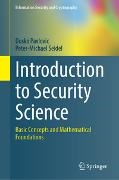Read more
Everyone needs security: Nations need national security, corporations need corporate security, individuals need personal security, cybersecurity, AI security. What is the common denominator of these security concepts?
Security and science are the building blocks of the modern civilization. Science gave us the powers to change the world. Security should protect us from abuses of those powers. Yet humans have been hesitant to apply the methods of science to the problems of security. This core security-science (SecSci) textbook is a step in that direction.
While many students pursue security out of genuine interest, most security curricula are plastered with industry buzzwords and policy slogans, driven by market incentives and government funding. The result is the attackers get richer, and their victims get poorer—while security experts inhabit the realm of informal narratives in-between. Before joining the fray, some students want to understand it. This textbook arose from the authors' efforts to cater to such students by peeling off the veils of expertise and replacing them with explanations and simple mathematical models.
Topics, goals and features:
- Understand the basic ideas behind the main security concepts and beyond the buzzwords
- Cybersecurity and computer security are not as different from physical security and national security as they make you think.
- Physical space is described by its geometry, but what is the geometry of cyberspace?
- Different programming languages and different network and computer architectures require different security tools. Learn the security methods independent on the differences.
- Privacy is not a security requirement but the right to be left alone.
- The more I trust you, the less security and privacy I need from you. But why do I trust you?
This uniquely informative textbook provides supporting materials for undergraduate and graduate courses on security, privacy, and trust. The early chapters introduce the basic concepts at the beginner level. The later chapters require some technical confidence and intellectual maturity. The book can also be used as an entry point into SecSci research.
The authors are professors at the Department of Information and Computer Sciences at the University of Hawai‘i at Mānoa.
List of contents
Preface.- Introduction.- Security Concepts.- Static Resource Security.- Dynamic Resource Security.- Geometry of Security.- Relational Channels and Noninterference.- Communication Channels, Protocols, and Authentication.- Information Channels and Security.- Privacy.- Trust.- Bibliography.- Prerequisites.- Appendices.- Index.
About the author
Dusko Pavlovic was born in Sarajevo, studied mathematics and programming in Utrecht, taught at McGill, Imperial College London, Oxford, and Royal Holloway, before joining University of Hawaii in 2014. In the meantime, he also spent 12 years talking about applications in Palo Alto CA. His research evolved from pure mathematics, through theoretical computer science and software engineering, to network computation and security, with excursions into quantum computation and game theory. He authored more than 100 articles, 2 books, and a play, so far. In his ample spare time he enjoys providing strategic advice to his 3 children and writing about himself in third person.
+++
Peter-Michael Seidel is an Associate Professor in the Information and Computer Sciences Department at the University of Hawaii at Manoa. He received BSc and MSc degrees in computer science from the University of Hagen, Germany in 1994 and 1996, and a Dr.-Ing. and a Habilitation degree in computer engineering from the University of the Saarland at Saarbruecken, Germany in 2000 and 2002, respectively. Prior to joining the University of Hawaii, he worked for Advanced Micro Devices as a PMTS design engineer from 2007 to 2012, and he was a faculty member in the Computer Science and Engineering Department at SMU from 2000 to 2007. His research interests include computer arithmetic, computer architecture, formal methods, and hardware security.
Summary
Everyone needs security: Nations need national security, corporations need corporate security, individuals need personal security, cybersecurity, AI security. What is the common denominator of these security concepts?
Security and science are the building blocks of the modern civilization. Science gave us the powers to change the world. Security should protect us from abuses of those powers. Yet humans have been hesitant to apply the methods of science to the problems of security. This core security-science (SecSci) textbook is a step in that direction.
While many students pursue security out of genuine interest, most security curricula are plastered with industry buzzwords and policy slogans, driven by market incentives and government funding. The result is the attackers get richer, and their victims get poorer—while security experts inhabit the realm of informal narratives in-between. Before joining the fray, some students want to understand it. This textbook arose from the authors' efforts to cater to such students by peeling off the veils of expertise and replacing them with explanations and simple mathematical models.
Topics, goals and features:
- Understand the basic ideas behind the main security concepts and beyond the buzzwords
- Cybersecurity and computer security are not as different from physical security and national security as they make you think.
- Physical space is described by its geometry, but what is the geometry of cyberspace?
- Different programming languages and different network and computer architectures require different security tools. Learn the security methods independent on the differences.
- Privacy is not a security requirement but the right to be left alone.
- The more I trust you, the less security and privacy I need from you. But why do I trust you?
This uniquely informative textbook provides supporting materials for undergraduate and graduate courses on security, privacy, and trust. The early chapters introduce the basic concepts at the beginner level. The later chapters require some technical confidence and intellectual maturity. The book can also be used as an entry point into SecSci research.
The authors are professors at the Department of Information and Computer Sciences at the University of Hawai‘i at Mānoa.

